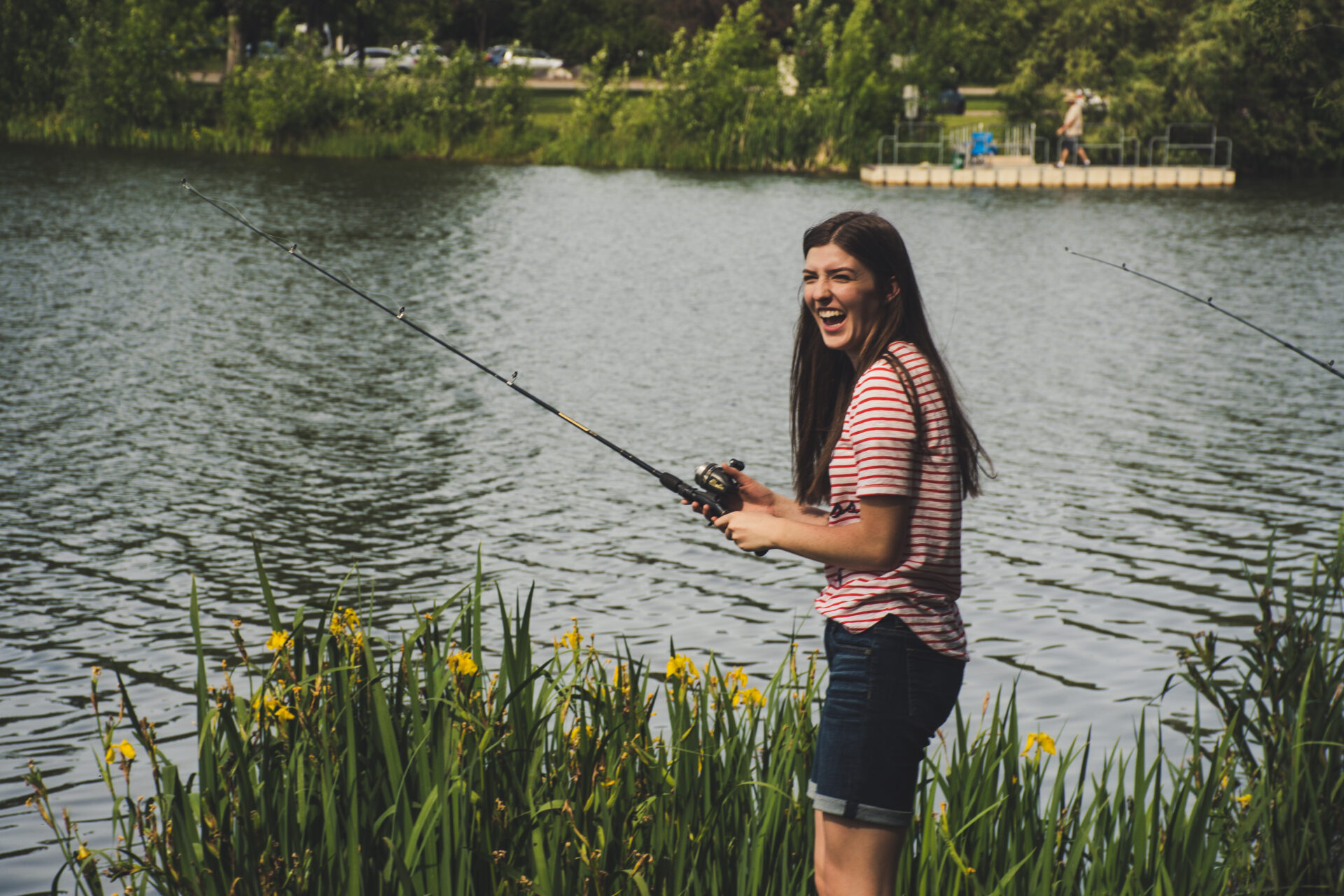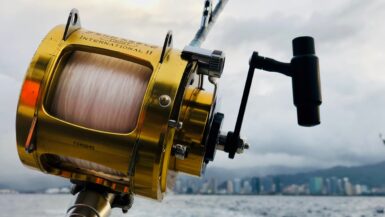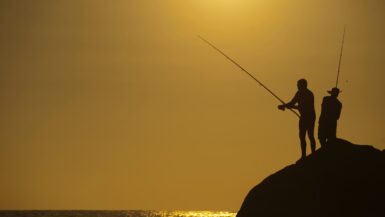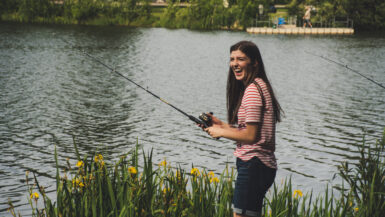Fishing for panfish in lakes is a great way to get outdoors and enjoy the fresh air. Panfish are small, edible freshwater fish with flat, slender bodies and large scales. Common examples of panfish include crappie, bluegill, and perch. Anglers of all skill levels can enjoy fishing for these tasty fish in lakes. It can be difficult to know where to start when it comes to catching panfish in lakes, but there are specific techniques that work best. In this article, we’ll look at the best techniques for catching panfish in lakes and how to use them to your advantage.
Family-Friendly Gear
When it comes to enjoying the sport of panfishing in a lake, there are some gear and tools that are necessary to have on hand. Everyone from experienced anglers to first-time panfishers needs to have the right gear in order to be successful. Here we will discuss the family-friendly gear that will help anyone catch panfish in lakes.
Fishing Rods and Reels
The primary gear that all panfishers need are a suitable fishing rod and reel. When it comes to panfishing, the lighter the better. Lightweight rods and reels make it easier to cast out and reel in panfish, and they are also less tiring to use over extended periods. Try to find a rod that is specifically designed for panfishing, as these will be shorter, more flexible, and easier to use than a full-sized rod and reel.
Panfish Lures
In order to catch a panfish, you need to have the right bait. For panfish, the best type of bait is a small jig or a panfish fly lure. These are specifically made to attract panfish, and they are the best way to catch them. You can easily find panfish lures in your local fishing store or online.
Fishing Line
In addition to the rod and reel, you also need to have the right type of line. Monofilament line is the most popular type of fishing line for panfishing, as it is lightweight and allows the bait to move freely in the water. When choosing a line, look for one that is rated for panfishing and is lightweight and flexible.
Fishing Nets
Finally, you also need to have a fishing net to help with catching your panfish. A small, lightweight net is best for panfishing, as it is easier to maneuver in the water and it is less likely to scare away the fish. When choosing a net, look for one that is specifically designed for panfishing and is made of a lightweight material.
With the right gear, anyone can enjoy panfishing in a lake. Making sure you have the right equipment is essential to having a successful day out on the water. By following this guide, you can make sure you have the family-friendly gear necessary for panfishing and you can have a great time catching panfish in lakes.
Choosing the Right Lake
When it comes to catching panfish in lakes, the first step to success is finding the right lake. The ideal lake should have a variety of panfish species, an abundance of weeds and other aquatic vegetation, as well as plenty of structure (stumps, logs, rocks, etc.) that can provide hiding places and ambush points.
It’s important to research different lakes and find out which one best suits your desired type of panfishing. Local bait and tackle shops are great sources of information, and many of them have detailed maps of popular fishing spots. You can also use the internet to find out more information about different lakes and their fish populations.
Factors to Consider When Choosing a Lake
When selecting a lake for panfishing, there are several factors to consider. The first is the type of panfish available in the lake, such as black crappie, bluegill and perch. Different types of panfish have different feeding habits and behaviors, so it’s important to know what types of fish are present.
It’s also important to look at the lake’s water clarity and depth. Clear water will allow you to see the fish and structure, while deep water provides plenty of hiding places. Additionally, check to see if the lake has an abundance of weeds and aquatic vegetation, which can provide great cover for panfish.
Finding the Perfect Spot
Once you’ve chosen the right lake, it’s time to find the perfect spot for panfishing. Look for areas with plenty of structure, such as logs, rocks, stumps, and weeds. These areas are usually the best spots to find panfish. Additionally, look for areas with shallow water, as panfish prefer to stay in shallower water during the day.
Once you’ve chosen the spot, it’s time to set up your equipment and start fishing. Remember to use the right bait for the type of panfish you’re targeting. Live bait, such as worms, minnows, and crickets, are usually the best option for catching panfish.
Conclusion
Catching panfish in lakes is a rewarding experience, and the key to success is finding the right lake with the proper habitat. With the right research, preparation, and technique, you can be sure to have a successful panfishing trip.
Understanding Panfish Habits
Panfish, or pan-sized fish such as sunfish, perch, and crappie, are an enjoyable and tasty addition to any fishing trip. To be successful in catching panfish, it is important to understand the behavior and habits of these fish, especially in lakes.
Foraging for Food
Panfish typically forage for food during the early morning and evening hours, when the water is cooler and the light is low. During the day, they tend to prefer deeper water with cover and structure, such as logs, rocks, and aquatic plants, which provide them with safety from predators. During the night, they often move near the surface where they can find insects and larvae, as well as some small baitfish.
Spawning Habits
One of the most important things to understand about panfish is their spawning habits. Most panfish, like most other fish, prefer to spawn in shallow water, usually during the spring. They also prefer areas with plenty of vegetation, as this provides protection for the eggs, as well as an ample food supply for the young fry. The eggs are usually laid among bottom vegetation, and the fry typically remain in shallow water until they are big enough to move to the deeper parts of the lake.
Group Behavior
Panfish often travel in large schools, especially during the summer months. The school typically consists of a single species, such as all bluegill, or all crappie, but there have been instances of mixed schools. It is also important to note that these schools often move from place to place throughout the lake.
What Bait to Use
The best bait to use for panfish in lakes depends on the type of panfish you are trying to catch. For example, small jigs, worms, and crickets are effective for catching bluegill and crappie, while minnows and crawfish work well for bass. Whatever the bait you are using, the presentation should be slow and subtle, as panfish are easily scared away by aggressive fishing techniques.
The Right Time to Fish
When it comes to panfish, timing is key. Early morning and late evening are often the best times to fish, as the panfish will be most active during these times. If you are fishing for bass, however, it is best to fish during the day when the water is warmer and more of the bass are likely to be actively feeding.
Understanding panfish habits will help you to be more successful when fishing for panfish in lakes. Panfish often forage for food in the early morning and evening hours and prefer to spawn in shallow water with plenty of vegetation. They also tend to travel in large schools and can be caught using different bait, depending on the species. Finally, timing is key when fishing for panfish, as they are most active during the early morning and late evening hours. With the right understanding and techniques, you will be ready to enjoy a successful fishing trip.
Reel in the Catch
Having the right setup when fishing for panfish is essential for successful angling. You should start by investing in quality gear – rods, reels, lines, and lures. For panfish, a light spinning rod and reel is usually best, with line in the 6 to 8lb range. Choose lures specifically designed for panfish, such as micro crankbaits, jigs, and spoons.
Choose the Right Spot
Once you have your gear in order, it’s time to choose a spot to cast. Look for shallow, weed-free areas of the lake where panfish are likely to be found. Keep an eye out for structure such as rocks or sunken logs, as panfish like to hide in these places.
Set the Hook
Once you have a bite, be sure to set the hook quickly and firmly. This will increase your chances of landing the fish. Start off with a light, slow reel and gradually increase the speed as the fish begins to tire. Pay attention to the feel of the line as you battle the fish – this will give you an indication of how much energy the fish has left.
Land the Catch
When you have reeled the panfish in close enough to the shore, you can reach down and grab it with your hand. It is important to handle the fish carefully and avoid squeezing it too hard, as this can cause internal injury. Once the fish is safely in your hands, quickly unhook it, weigh it, and release it back into the water.
Know Your Limits
It is important to know your state’s fishing regulations when it comes to panfish. Many states have limits on the number of fish you are allowed to keep, as well as size and creel limits. Be sure to follow these rules to avoid costly fines or fines.
Enjoy Your Catch
After a successful day of panfishing, it’s time to reap the rewards! Panfish are a delicious and versatile fish to eat, and can be prepared in a variety of ways. From frying, to baking, to smoking, there are many delicious recipes to be enjoyed from your catch.
Trying Different Strategies
If you are trying to catch panfish in a lake, one of the best techniques is to learn about the fish’s diet. Knowing what the fish like to eat can help you choose the right bait or lure. Panfish such as bluegill and sunfish tend to feed on small crustaceans and aquatic insects. You can use live bait such as worms, maggots, or crickets to attract them. If you are fishing with lures, you should use small jigs and spinners that imitate these small critters.
Location Matters
Location is another important factor when it comes to catching panfish in lakes. Panfish like to stay in shallow water, near the shoreline or in weedy areas. These areas provide them with cover from predators and food sources such as small insects and crustaceans. Look for areas with vegetation, drop-offs, or even submerged logs and stumps. These are all good places to cast your line and try your luck.
Time of Day
The time of day can also have an effect on your success when it comes to catching panfish in lakes. Fish are more active in the early morning and late evening, so these are the best times to go fishing. During the middle of the day, most fish will be less active, so it may be better to wait until the evening to fish.
Changing Up Your Tactics
If you have been fishing in one spot for a while and not having much success, it may be time to try something different. Move to another part of the lake and try different techniques. You can try different baits, lures, and even different presentations. This can help to keep the fish interested and could lead to more success.
The Right Gear
Finally, make sure you have the right gear for the job. Depending on the type of panfish you are trying to catch, different gear may be required. If you are fishing for small sunfish, a light spinning rod and reel will work well. If you are fishing for larger bluegill, a fast action spinning rod and reel may be better. Choose the right gear for the job and you will have much better chances of catching panfish.
Water Level Considerations
Catching panfish in lakes requires anglers to pay close attention to the water levels in the lake. Lower water levels can make it more difficult for panfish to move around and feed, while higher levels can result in areas of the lake becoming flooded, making cellars and other hiding spots inaccessible. Understanding the effects of water levels on panfish can give anglers an advantage when fishing.
Selecting Bait & Lures
Panfish are opportunistic feeders and will often take a variety of baits and lures. Live bait like worms, minnows, and crickets can be effective, as can a variety of artificial lures like spinners, jigs, and spoons. Experiment with different colors and sizes of bait and lures to find the most productive combinations.
Identifying Ideal Structures
Panfish will often hide or congregate near structures in the lake, typically natural objects like logs, rocks, and weed beds. They may also be attracted to man-made structures, such as boat docks, docks, bridges, and submerged trees. Anglers should use the structures in the lake to their advantage, finding areas where panfish could be hiding or feeding.
Targeting the Right Season
Panfish are active throughout much of the year, but their behavior can vary based on the season. In the spring, they will typically be found in shallow water, near the shore. During the summer and fall, they often move to deeper water and structure, and in the winter, they will hunker down in the deepest parts of the lake. Being aware of the seasonal patterns of panfish can help anglers plan their fishing trips more effectively.
Applying Strategic Tactics
Once a spot has been located, there are various techniques anglers can use to target panfish. Drifting is a tactic that can be used to cover a large area quickly and keep lures or bait in the strike zone for longer. Casting and trolling are methods that can effectively cover more areas and allow anglers to reach greater depths. Experimenting with these techniques and learning which works best for a particular lake can help anglers be more successful.
Paying Attention to Water Levels
Water levels in lakes can change quickly, and anglers need to pay careful attention to these fluctuations. Low water levels can cause fish to move to deeper areas of the lake or to find cover in areas that remain accessible. High water levels can make some areas of the lake flood, forcing fish to move to different places. Understanding how water levels affect panfish can be critical to successful fishing trips.
Panfish Fishing Tips for a Successful Outing
Catching panfish in lakes is an enjoyable pastime that can lead to a successful fishing outing. Basic fishing techniques like using live bait, soft plastic lures or jigs, or artificial lures can all be effective in taking panfish. It’s helpful to know where in the lake the panfish will be located and to use the right size hook and tackle for the species you are trying to catch. It’s also a good idea to come prepared with several different types of bait and lures so you can find what the panfish prefer. Lastly, remember that the key to catching panfish is patience. It may take some time, but if you keep at it you’re sure to have success.





Leave a reply